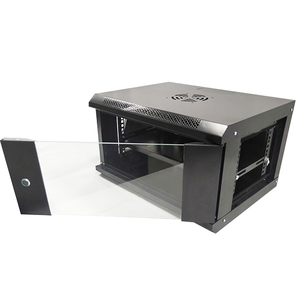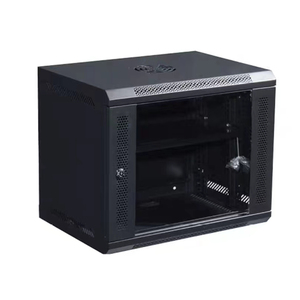(4242 products available)
































































































































































































A rack cabinet 6U is a compact storage solution used to secure and organize various electronic equipment. It typically has six vertical units (U), where one U equals 1.75 inches. Therefore, a 6U rack cabinet measures approximately 10.5 inches tall. Moreover, it comes in different models, including open frame racks, wall-mounted racks, and server racks.
Open frame 6U rack
An open frame rack doesn't have any doors or side panels. It's a bare frame with vertical rails where equipment can be mounted. The open frames provide easy access to the mounted devices from the front and back. They are also lightweight and, therefore, easy to move around. Besides, open frames promote excellent airflow around the equipment. As a result, it helps to keep devices cool, especially during heavy operations. Additionally, the racks don't have any enclosed shelves. Consequently, they are only suitable for storing equipment in areas with low or moderate security.
Wall-mounted 6U rack
A wall-mounted 6U rack is a versatile storage solution that can be mounted on the wall or used with a stand. It has a fixed assembly with no possibility of sliding or pivoting. Also, the rack has an electronic connection that integrates several devices into a single unit. The mount can be either fixed or movable. A wall-mounted rack saves a lot of floor space, reducing clutter in the house or office. It can hold up to six units (6U) of equipment and is commonly used for network and telecom devices.
Server rack
A server rack is a type of 6U rack with a cabinet design. It features shelves with doors for securing valuable electronic equipment. The shelves can be pulled out for easy access to the devices. Server racks are not only convenient but also efficient. They maximize storage by neatly organizing all cables and servers. These racks are also suitable for managing servers, switches, patch panels, and other vital network components.
Since small 6U rack mount cases are designed for limited spaces, they have features that help store and protect equipment in tight areas.
Small Footprint
The 6U rack is built for small or limited spaces. So, it has a shallow depth compared to larger racks. This design allows it to fit snugly against walls or in tight corners where a full-size rack cabinet could not go. Using a 6U rack in these locations helps make better use of limited space at the facility.
Compact Size
Both the height and depth of the 6U rack are smaller than larger racks. With only 6U of vertical space, it can only hold 6U of mounted equipment. The smaller size makes it easier to transport, store, or install in cramped areas where a larger rack would be too much.
Accessibility
A compact rack is easy to access. Users or technicians can comfortably reach all cabled connections, controls, or indicators without stretching or straining. This allows for simple operation, monitoring, and any required adjustments even when installed in confined locations.
Lightweight
Due to their smaller size, 6U racks are made to be light in weight. This makes them easy to move around an office, workspace, or wherever else the equipment is needed.
Limited Mounting Options
The 6U rack only has space to hold 6 units of equipment. So, it is built with only the most basic mounting options. These include flat surfaces to place or attach items and small side rails to keep things steady. The limited mounting makes it less complicated.
Cost-Effectiveness
Using a compact 6U rack costs less than bigger racks, so they are more affordable.
Portability
Some small racks have handles or wheels, making it easier to move the rack around when needed.
Rack Mount Accessories
Compact racks often come with extra items like shelf trays for storing things, spacers to protect devices, or brackets that allow attaching the rack to a wall instead of just on the floor.
Airflow Management
Compact racks need airflow management too. This allows air to flow well so devices inside do not overheat. Air vents help keep things cool even in a compact space.
Security Features
Users can lock some small racks to stop others from accessing the sensitive equipment inside.
The 6U rack is a popular choice for various businesses and industries thanks to its optimal balance between space and versatility. Here are some of its common usage scenarios:
Networking and Server Management
Businesses use the 6U rack to organize and secure their network equipment, servers, and other critical infrastructure. Whether it is a small office with a few switches and routers or a larger organization that requires server storage and rack space, the 6U rack provides an ideal solution.
Telecommunication Centers
Telecom companies can employ the 6U rack to house the transmission equipment, routers, switches, and other devices in their central offices or cell sites. Its compact design makes it possible to maximize limited telecom room space while maintaining order and ensuring accessibility to the equipment.
Data Centers
6U rack cabinets are integral to most data centers because they provide secure standardized enclosures for hosting servers and other IT assets. Data center managers can utilize the racks to optimize operations and achieve more by consolidating resources and maximizing floor space.
Broadcast and Media Production
The media and broadcasting industries use the 6U rack to manage and organize equipment such as video encoders, audio processing gear, broadcast controllers, and other essential devices mounted in a rack. This frees up workspace and keeps it tidy while ensuring easy access to all equipment.
Industrial and Laboratory Settings
6U rack enclosures can be used to store and safeguard instruments, controls, and computing devices in industrial plants, laboratories, and research facilities. The racks help keep the work areas organized while providing a secure solution for essential equipment.
Educational Institutions
Universities, colleges, and schools can use the 6U rack to set up network infrastructure in classrooms, computer labs, or libraries. The racks provide an orderly and secure means of housing routers, switches, and servers in an education environment.
After considering the important factors when selecting a rack cabinet 6U, here is a summary of major steps to take.
Q1: What is the maximum weight the 6U rack mount cabinet can support?
A1: All rack cabinets have a specific weight capacity. It depends on the materials used to make the rack and the design. The capacity is usually listed in the specifications. To avoid accidents, users should not exceed the weight limit. It's best to check the manual for instructions on how to determine the rack's weight capacity. Also, remember the weight capacity of a rack can vary based on its size.
Q2: How much space is there between each unit in a 6U rack?
A2: The space between each rack gets determined by the size of the equipment. The 6U size means it has 6 spaces. Each space is one standardized unit. Users need to check the specifications of each device to know if it will fit. The connectors and handles need room too. Using a ruler or measuring tape can help check if everything fits properly. Make sure to leave some extra space for air flow around the devices.
Q3: Can a 6U rack cabinet be locked for security?
A3: Yes, many 6U rack cabinets come with locks to keep the valuable IT gear safe. The locks are strong so only authorized people can get inside. Some cabinets let the front and back doors have separate locks. This allows safe access even when keeping the equipment secure. In addition to locks, administrators can use part numbers or codes to control who can open the cabinet. This helps makes sure only trusted people can access the sensitive servers and network devices kept inside the racks.
Q4: What does 6U mean in a rack?
A4: The term "U" means "Unit" or "Rack Unit". It is a measure used to show how big equipment is when mounted in a rack. One "U" is equal to 1.75 inches (44.45 mm) in height. So, a 6U rack would be 10.5 inches tall. The 6U means the rack can hold up to six separate units of equipment that each take up one "U" of space. Using "U" gives a standard measurement to know how much height fits in a rack. This helps make sure devices are compatible with each other without mismatches in size.